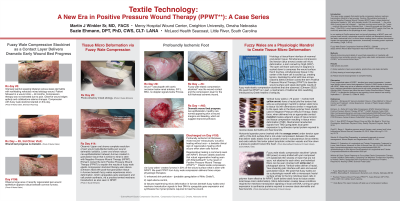Case Series/Study
(CS-171) Textile Technology: A New Era in Positive Pressure Wound Therapy (PPWT**): A Case Series
Friday, May 2, 2025
7:45 PM - 8:45 PM East Coast USA Time

Suzie Ehmann, DPT, PhD, CWS, CLT-LANA – Edema Management Specialist, McLeod Health Seacoast
Introduction: This case series suggests that elastic textile compression delivers mechano transduction effective to heal wounds. Caroline Fife published polaroids of her first Negative Pressure Wound Therapy (NPWT) case, a large abdominal dehiscence treated in 1997 with dramatic results. Fife reminisces “... the entire field of wound care had changed … had been running wound center for 7 years ... could do little more than Ambroise Paré, ‘I dress the wounds and God heals them.’” (Fife 2019). Louis Argenta published dramatic NPWT results, like Pare, he could only speculate on the physiology at work. (Argenta. L, 1997). In our reading of Orgill’s seminal work on the cell physiology of NPWT, open cell polymer foam acts as a physiologic mandril to deliver sub atmospheric pressure, aka static mechanical force, to wound tissue creating tissue mechano transduction signals that upregulate gene expression, dramatically increasing protein synthesis and healing. (Orgill, D 2013).
Fuzzy Wale Elastic Compression Stockinet (FWEC)*, (Sibbald 2022) delivers Wound Bed Preparation that rivals NPWT - what’s going on?
Methods: Wound photos document details of wound bed preparation in 5 patients with refractory lower extremity wounds, using fuzzy wale elastic compression stockinet (FWEC)* as the wound contact layer.***
Results: Clear photos document:
(1) Early resolution of peri wound edema, lymphorrhea, stasis dermatitis.
(2) Early clearing of wound edge epiboly.
(3) Robust wound bed progression to complete healing.
Discussion: Fuzzy longitudinal wales of FWEC* stockinet as a wound contact layer delivers robust ‘wound bed preparation’ (Schultz G 2003) similar to that seen with NPWT. Wales may act as an effective mandril to deliver static physiologic force, mechano transduction signals sent to cell nuclei upregulate protein synthesis. (Winkler 2023) Ehmann has coined the term Positive Pressure Wound Therapy (PPWT)** to describe the findings we are reporting--future research has exciting implications.*** (Ehmann S., Ostler M. 2022)
Fuzzy Wale Elastic Compression Stockinet (FWEC)*, (Sibbald 2022) delivers Wound Bed Preparation that rivals NPWT - what’s going on?
Methods: Wound photos document details of wound bed preparation in 5 patients with refractory lower extremity wounds, using fuzzy wale elastic compression stockinet (FWEC)* as the wound contact layer.***
Results: Clear photos document:
(1) Early resolution of peri wound edema, lymphorrhea, stasis dermatitis.
(2) Early clearing of wound edge epiboly.
(3) Robust wound bed progression to complete healing.
Discussion: Fuzzy longitudinal wales of FWEC* stockinet as a wound contact layer delivers robust ‘wound bed preparation’ (Schultz G 2003) similar to that seen with NPWT. Wales may act as an effective mandril to deliver static physiologic force, mechano transduction signals sent to cell nuclei upregulate protein synthesis. (Winkler 2023) Ehmann has coined the term Positive Pressure Wound Therapy (PPWT)** to describe the findings we are reporting--future research has exciting implications.*** (Ehmann S., Ostler M. 2022)

.jpg)